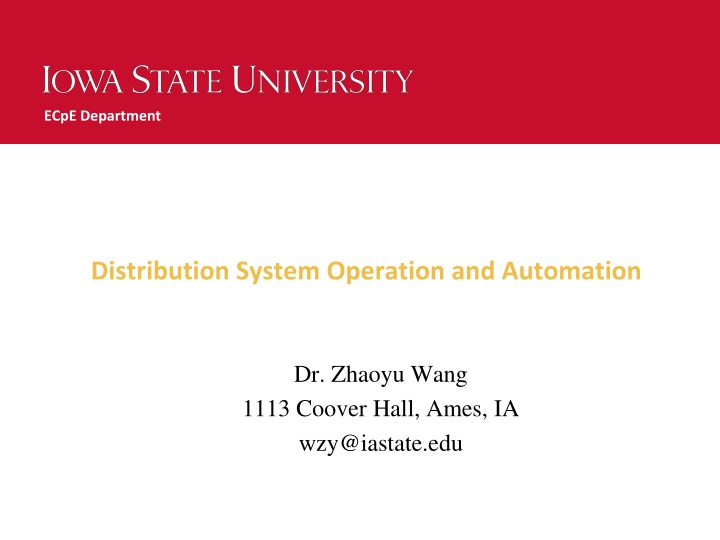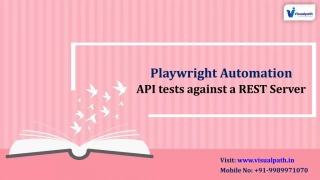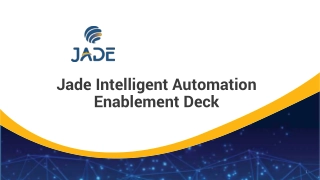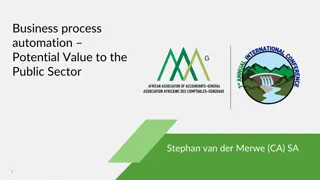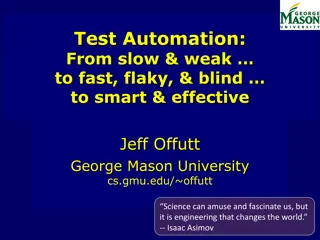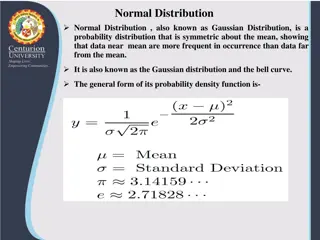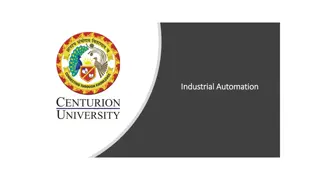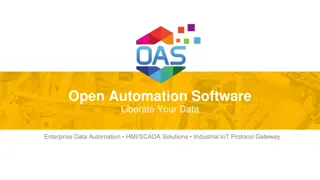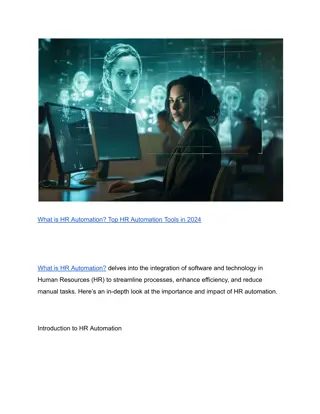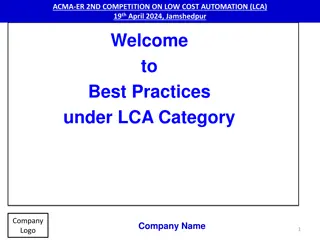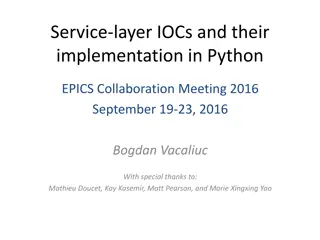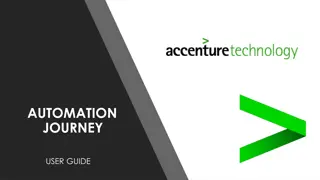Distribution System Operation and Automation Overview
Distribution system operation involves various switching activities like restoration after outages, substation maintenance, load transfers, and more. A midsize US utility typically executes 10 to 20 switching orders daily. Distribution automation (DA) aims to improve supply reliability and efficiency through real-time control technologies. Despite slower progress in distribution systems, DA offers flexible control enhancing system efficiency and reliability.
Download Presentation

Please find below an Image/Link to download the presentation.
The content on the website is provided AS IS for your information and personal use only. It may not be sold, licensed, or shared on other websites without obtaining consent from the author.If you encounter any issues during the download, it is possible that the publisher has removed the file from their server.
You are allowed to download the files provided on this website for personal or commercial use, subject to the condition that they are used lawfully. All files are the property of their respective owners.
The content on the website is provided AS IS for your information and personal use only. It may not be sold, licensed, or shared on other websites without obtaining consent from the author.
E N D
Presentation Transcript
ECpE Department Distribution System Operation and Automation Dr. Zhaoyu Wang 1113 Coover Hall, Ames, IA wzy@iastate.edu
Distribution System Operation and Automation Acknowledgement: The slides are developed based in part on Electric Power and Energy Distribution Systems, Models, Methods and Applications, Subrahmanyan S. Venkata, Anil Pahwa, IEEE Press & Wiley, 2022 2 ECpE Department
1. Overview Distribution system operation involves various switching activities: o Restoration after outages o Substation maintenance and clearance o Load transfers to alleviate overloads o Capacitor switching o System reconfiguration o Disabling automatic reclosing for live line work and turning on instantaneous tripping for live line work o Temporary switching for other work and planned outages Usually, all planned switching operations should be done without any interruption of service. 3 ECpE Department
1. Overview A midsize US utility typically executes 10 to 20 switching orders per day in a distribution system, varying in length from a few steps to hundreds. Most are planned operations with written instructions to respond to a switching request, while some relate to outages. The number can be weather-dependent, surging into the hundreds during severe weather conditions. Around 4500 switching orders were reported by a utility in 2008. The number has escalated due to increased maintenance spending, and more outages due to severe weather and an aging system. Monitoring substation alarms from SCADA, processing outage management, and troubleshooting, the distribution control center is responsible to determine whether switching requests can be granted after proper system analysis. Conventionally, most of the distribution system operations are executed manually. With the advancements in communications and computer technology, they are gradually becoming automated, which brings the concept of distribution automation (DA). 4 ECpE Department
2. Distribution Automation Deregulation and restructuring push utilities towards higher supply reliability and quality at distribution level. Meanwhile, utilities aim to improve system efficiency by reducing system losses. Originating in the 1970s, DA evolved with monitoring, control, and communication technologies. It provides real-time computation, communication, and control of distribution systems. Progress of DA has been relatively slower in distribution systems than in generation and transmission systems. The main reason is the utilities cost concern. However, DA provides many intangible benefits: o It provides flexible control of distribution systems, which enhances efficiency, reliability, and quality of electric service. o It leads to more effective utilization and life extension of the existing distribution system infrastructure and enhances system resiliency. 5 ECpE Department
2. Distribution Automation DA functions can be categorized into monitoring and control functions. o Monitoring functions include recording meter readings, switching device status, and abnormal events. o Control functions involve switching operations, system protection, and some specific customer service (e.g. automated meter reading, remote load control and demand response). Evolving as part of AMI, a separate area of smart grid. Application of distribution level power electronic devices can benefit the control in a rapid time frame: STATCON, inverter based resources. Those devices with DA are supposed to integrate to deliver high quality electric power to the end users, but the implementation in distribution systems is limited. Equipment reliability was a major concern until the early 1990s. Equipment available now is more reliable and robust, but still several issues remain, like cost, hardware and software standards, and interoperability. 6 ECpE Department
2. Distribution Automation DA implementation requires careful planning. Two approaches can be adopted: top-down and bottom-up. Top-down: revolutionary, large scale, fully integrated automation system with all or most functions. Bottom-up: evolutionary, integrate automation devices for only selected functions, or a small part of system. Other functions or parts can be automated gradually. The top down approach is expensive and requires great modifications, so it is suitable for only a few utilities. The bottom up strategy is more suitable for a majority of utilities since it allows them to adjust gradually and install automated systems for their immediate needs. The main difficulty for contemplating DA is to identify the functions to be automated. It can depend on geographic location, operating philosophy, and financial situation. 7 ECpE Department
3. Communication Infrastructure DA system relies on communication infrastructure to connect customer locations, control points, and energy management system. Communication infrastructure is hybrid, utilizing various mediums for different parts. Early DA systems used telephone for communication between the control center and the substation and PLC/radio between substation and customers. PLC-based communications suffered from attenuation (specifically transformers), and gradually decreased in popularity. Advances in radio technology and the availability of the 900 MHz frequency spectrum make radio a popular and reliable communication medium. Fiber optic cables are used along feeders to concentrators, then radios can reach customers from those points. Cellular telephone technology can also be used for some applications in distribution systems. Satellite communication has been experimented with, but not widely used. 8 ECpE Department
4. Distribution Automation Functions DA functions can be categorized into customer-level and system-level functions. o Customer-level functions: require communication-capable devices at customers premises, including meter reading, demand response, time-of-use rates, outage alerts, and remote connect/disconnect. o System-level functions: related to system operations, devices installed at substations and feeders, including fault detection and service restoration, feeder reconfiguration, voltage/VAR control, equipment monitoring, and digital protection. This chapter focuses on system operation-related functions, while customer- related functions can be implemented as a part of AMI. Operation-related functions can be divided into substation- and feeder-related functions. Four important functions are covered: (1)outage management, (2)feeder reconfiguration, (3)voltage and reactive power management, and (4)equipment monitoring and control. Substation and feeder functions can overlap and be coordinated in some cases. 9 ECpE Department
4.1 Outage Management Distribution systems, particularly with a large percentage of overhead feeders, are susceptible to various types of faults due to exposure to the environment. While underground feeders are not exposed to several environmental factors, they also experience faults. Also, a large majority of distribution systems around the world are overhead due to cost considerations. Since underground feeders typically cost 5 10 times more than overhead feeders, so they are used only in special situations where aesthetics or higher reliability is of concern. The system can have either a temporary or a permanent fault. For a temporary fault, the affected customers experience interruption of power for a very short duration, which is typically in seconds. In the event of a permanent fault, the protective devices are expected to operate and isolate the faulted section, which results in longer service interruption for the customers. However, if the fault is of a high impedance type, the protective devices might not operate to isolate the faulted section. In such situations, locating faults becomes more difficult. 10 ECpE Department
4.1 Outage Management If no information on the status of various devices in the distribution system is available to the distribution system dispatchers, there is no direct way to find out about the outages. The dispatchers depend on telephone calls from customers or a sudden change in power flow at a metered location upstream in the system to come to know of the outages. Calls from customers only provide an approximate location of the outage. Moreover, in the case of a major storm, multiple outages can be widespread and difficult to locate: Once the approximate location of outages is known, line crews are dispatched to drive along the lines to look for damage. After the damaged area is located, it has to be isolated from the rest of the system if the protective devices have not done that already. The next step is to restore power to those parts of the system that are undamaged but have power interruption due to problems elsewhere in the system. The power to these parts may be provided from alternates routes. The dispatchers determine such possible routes and ask the line crew to operate switches. Many of the switches cannot be operated under load; therefore, the substation breaker has to be opened before operating them. If the whole process is done manually, it takes a long time. 11 ECpE Department
4.1 Outage Management Automation of this function requires installation of remotely controlled sectionalizers and sensors on the feeders and leveraging AMI at customer locations to detect interruption of service. Upon loss of power, the meter automatically sends a message, or the outage is detected when the metered information is not received at the end of the metering duration. In the latter case, there can be a delay up to the metering duration, for example 15 minutes, if the outage happens at the beginning of the metering duration. Since the activity of locating outages has historically depended on customer calls, it is called Trouble Call Analysis in the utility jargon. Once sufficient calls are received, locations of the outages are determined based on the escalation of data from the customer level to the substation level. To aid the operators in an outage location, the calls are automatically mapped on the system map. However, simple escalation can lead to wrong diagnosis, specifically during multiple outages. Therefore, advanced inferencing techniques are used to determine possible locations of faults. Installation of sensors on the feeders to obtain additional information also increases the possibility of correct diagnosis. One approach requires recording the time of service interruption at different locations in the system. Techniques based on voltage sags are also used for location of outages. In general, it is easier to locate the main feeder outages but more difficult to locate lateral outages. 12 ECpE Department
4.1 Outage Management The next step is the restoration of service to customers. If the fault happens on the main feeder, power to the unfaulted section of the feeder is restored by automatically closing a tie switch, which routes power from a neighboring feeder. Following that, the crew is directed toward the faulted section to fix the problems, and to restore service. If the fault is on a lateral, restoration requires replacing the fuse manually after the crew has made repairs. Laterals usually do not have a tie switch from a neighboring lateral. Also, replacing fuse by an automated sectionalizer is a very expensive proposition because a distribution system of a small city may have hundreds of laterals. With the cost of an automated single phase sectionalizer about $10,000 and the cost of a fuse for the same lateral about $50, it is difficult to justify replacing the fuse by an automated sectionalizer. As automation of this function provides more precise location of the outages, the crew goes to the identified location instead of looking for problems in a general area. Thus, with automation, the whole process of outage location and service restoration can be accomplished more efficiently by less people in much less time with minimum interruption to the customers. 13 ECpE Department
4.2 Feeder Reconfiguration Load variation occurs hourly, daily, and seasonally in distribution systems. Optimal feeder configuration is crucial. Previously focused on minimum losses. Service reliability now is equally important. Multi-objective reconfiguration includes objectives like loss minimization, load balancing, and voltage deviation. Reconfiguration involves opening closed switches and closing open ones while maintaining radial structure and continuous power supply. Manual reconfiguration is seasonal and infrequent due to complexity and service interruptions. Automated reconfiguration uses sectionalizers for fault isolation and restoration. Remote control allows more frequent reconfiguration. Challenges include: Creating loops temporarily, then restoring radial structure. Switch wear and tear, impacts switch lifespan. Trade-off between benefits of frequent reconfiguration and switch replacement cost. 14 ECpE Department
4.3 Voltage and VAr Management Voltage and reactive power management is crucial for ensuring proper service voltage and minimizing losses. Customer loads are mainly inductive, necessitating capacitors for reactive power compensation. Coordination between LTC at the substation transformer, switched capacitors, and line regulators is essential. Substation LTC ensures proper voltage levels from the transformer. Switched capacitors provide reactive power compensation in the distribution system. Line regulators help maintain voltage levels by adjusting tap positions. Proper management of these devices ensures efficient system performance and customer satisfaction. 15 ECpE Department
4.3.1 Transformer LTC Operation LTC (Load Tap Changer) adjusts tap position in response to load. Higher load causes more voltage drop on feeders. Tap moves higher to maintain proper voltage along feeders. Lower load results in lower voltage drop; tap moves lower. LTC responds to feeder voltage measured at substation to maintain voltage levels across the system. Another approach is the line-drop compensation scheme regulates voltage at specific points on feeders using voltage-regulating relays. Relay voltage = Substation voltage - Estimated feeder voltage drop. Previously, there s no direct voltage measurements on feeders. Control was based on estimations and effected by the customers at the end of the feeder. Now, utilities are installing voltage measurements, typically at the end of the feeder to provide precise and optimal control of LTC. It also enables implementation of conservation voltage reduction (CVR) strategies to reduce system demand. 16 ECpE Department
4.3.2 Capacitor Operation Capacitors in distribution systems provide voltage and reactive power support. Capacitors can be fixed or switched, strategically placed for system improvement. The switch status is based on signal from controlling device: o Timer-based control assumes load patterns but doesn't account for variations or holidays. Temperature-sensitive control has limitations due to lag in air- conditioning demand. o Microprocessor-based controllers with communication offer improved control. It communicates with central station for coordination, but don't consider system-wide impacts. Optimal Capacitor Configuration: o Achieved with higher automation level. o Meters are required to measure real/reactive power, voltage, current. o Data sent to central computer for optimal switching. o Minimize losses, keep voltages within limits. 17 ECpE Department
4.3.2 Capacitor Operation Benefits of real-time measurement capabilities : o Allows frequent switching for optimal operation. o Prevents frequent switching to avoid equipment failure. o Addresses power quality concerns. Future Prospects: o Power electronics-based schemes for reactive power control. o Eliminate concerns of mechanical switching. 18 ECpE Department
4.3.3 Regulator Operation Voltage regulators are autotransformers used in distribution systems for voltage control. They are especially useful on long distribution lines with high voltage drops. Regulators are set to maintain voltage within a specified range. When voltage drops below the low setting, the tap moves to increase output turns. When voltage exceeds the high setting, the tap moves to reduce output turns. Regulators use line drop compensation to regulate voltage at a specified downstream point. Implementation of DA allows actual voltage measurements for regulator control. DA enables coordination of regulator operation with capacitor switching for loss reduction and improved voltage profile. Better voltage profile leads to fewer low voltage complaints from customers. 19 ECpE Department
4.3.4 Smart Inverters Impact of Increased IBR (Inverter-Based Resources) Proliferation: o Integration of IBRs like solar PV challenges voltage and var management. o Injection of real power causes voltage rise. o Intermittent solar PV output leads to voltage fluctuations. Smart Inverter Evolution: o Earlier inverters lacked reactive power control options. o Currently, inverters can offer smart reactive power control. o Options for local or coordinated control. Challenges of Coordinated Control: o Coordinated control requires fast data processing and communication. o Centralized control in large systems is impractical. o Hybrid approach with distributed data management is feasible. 20 ECpE Department
4.3.4 Smart Inverters Data Ownership and Control: o Customer-owned rooftop solar PV behind the meter. o Utilities lack data access and control jurisdiction. o Control necessitates special agreements between utilities and customers. FERC Order 2222 and Aggregators: o FERC order allows third-party aggregators to coordinate behind-the-meter resources. o Aggregators gain data access and control over devices. o Need for coordination between aggregators and utilities. Complexities of Aggregator Coordination: o Many aggregators involved with customers in a distribution system. o Balance needed to prevent adverse impacts on distribution systems. 21 ECpE Department
4.3.4 Smart Inverters Potential Smart Inverter Architecture: The architecture for leveraging smart inverters. figure illustrates an Investigation ongoing, no single solution yet. Fig. An architecture for transactive energy in distribution systems 22 ECpE Department
4.4 Monitoring and Control Distribution system monitoring serves a purpose similar to traditional SCADA systems. Monitoring is essential for data acquisition for various distribution functions. Real-time data is required for functions that make immediate control decisions. Real-time data provides alarms to operators for abnormal system conditions. System data can be archived for future use in forecasting and planning. Monitoring assists in managing major assets like substation transformers and circuit breakers. Monitoring plays a crucial role in various aspects of distribution systems. 23 ECpE Department
4.4.1 Transformer Life Extension Substation transformer are usually operated below capacity, but can handle emergency overloads. Overloading should be limited by time to avoid damaging transformers. In manual processes, dispatchers use trial and error for load management. They close switches to add load, aiming for a certain limit. If actual load surpasses this, they open switches, disconnect feeders, and repeat the process. Frequent switching strains transformers, shortening their lifespan. Proper monitoring: reduces switching operations, minimizes transformer stress Monitor the oil and winding temperatures determine the level of overloading. Select feeders for balanced loading and desired levels. Limit the overloading of the transformers without too many swithcing operations. Such monitoring and control of distribution transformers is very challenging due to a large number of such transformers in the system and high expense. But with increased EV and rooftop PV, the monitoring of transformers can be more essential. 24 ECpE Department
4.4.2 Recloser/Circuit Breaker Monitoring and Control Remote Monitoring and Control Limitations: o Circuit breakers and reclosers lack remote monitoring and control. o Settings adjustments require physical presence at equipment location. o Pole-mounted reclosers' settings changes are time-consuming. Maintenance Challenges Without Monitoring: o Contacts of reclosers and circuit breakers refurbished at fixed intervals. o Maintenance frequency often conservative, leading to premature service. Benefits of Automation: o Automated scenario allows remote relay settings and recloser timings. o Improved system control and protection during configuration changes. o Remote settings save labor for adjustments. o Precise energy interruption monitoring for contact health assessment. 25 ECpE Department
4.5 Cost Benefit of Distribution Automation Assessing costs and benefits is crucial for DA implementation decisions. Automation costs include communication, hardware, software, training, etc. Categories of Benefits: o Efficiency: reduced losses, peak power demand, and manpower needs. o Reliability: fewer, shorter power interruptions, equipment failure prevention. o Power quality: fewer momentary interruptions, voltage issues. o Resiliency: aiding recovery from extreme weather events. 26 ECpE Department
4.5 Cost Benefit of Distribution Automation In essence, the process involves: 1. Mapping DA functions to operational benefits. 2. Mapping operational benefits to monetary benefits. 3. Comparing outcomes with existing methods. 4. Estimating values for missing or uncertain variables. 5. Conducting sensitivity analysis to determine key variables. This approach enables utilities to make informed decisions regarding the implementation of DA functions based on their cost-effectiveness and potential benefits. 27 ECpE Department
4.5 Cost Benefit of Distribution Automation Table: Mapping the benefits of distribution automation functions. 28 ECpE Department
4.5 Cost Benefit of Distribution Automation To illustrate the computation of monetary benefits of different operation benefits, few examples of operational benefits of outage management are provided below. 4.5.1 Higher Energy Sales With faster restoration, the customers receive service sooner than with the traditional approach. This in turn results in additional revenues for the utility for selling electricity to the customers. Annual Benefit= (Cost of energy in$/kWh)(Average Customer Demand in kW) (%of System Lost/100)(Number of Customers) (Line Failures per Year per Mile)(Circuit Miles) (Average Decrease in Outage Hours per Event) 29 ECpE Department
4.5 Cost Benefit of Distribution Automation 4.5.2 Reduced Labor for Fault Location With automation, faults can be located sooner, which saves time spent on the task for the field crew as well as the operators. This in turn results in labor cost savings. Annual Benefit= (Line Failures per Year per Mile)(Circuit Miles) (Line Crew Hours per Fault)(Line Crew $/Hour) +(Operator Hours per Fault)(Operator $/Hour) 30 ECpE Department
4.5 Cost Benefit of Distribution Automation 4.5.3 O&M of Switches and Controllers Automated switches will have different failure rates and repair cost than the manual switches. Difference in these costs must be accounted. This quantity will be a benefit if it is positive and will be additional cost if it turns out to be negative. Annual Benefit or Cost (Manual Switches per Feeder)(Failure Rate of Manual Switches) (Repair Cost per Manual Switch) (Automated Switches per Feeder) (Failure Rate of Automated Switches)(Repair Cost per Automated Switch) (Number of Feeders) = 31 ECpE Department
4.5 Cost Benefit of Distribution Automation 4.5.4 Lesser Low Voltage Complaints Automation is expected to provide better voltage at customer ends, which will result in lower low voltage complaints. This will result in savings because the utility has to spend time and resources to investigate the cause of such complaints. Annual Benefit= X X (Cost per Complaint)(Number of Customers)/1000 where X is the complaints without automation per thousand customers per year and X' is the complaints with automation per thousand customers per year. 32 ECpE Department
4.6 Cost Benefit Case Study Example Systems and Functions: o Urban and rural distribution systems considered for DA implementation. o All automation in rural system. functions considered for o In urban system, all except voltage regulator control. Table1. Data for the two example systems. Data and Analysis Software: o Data from [1] is used for the systems. A summary is provided in Table1. [1] Distribution Planning Reference Book. New York, NY: Marcel Dekker, Inc. Willis, H.L. (1997). Power o Economic analysis duration: 15 years. [2] Shultis, J.K. and Pahwa, A. (1992). A User's Guide for PC ADAM. Research Report 237, Kansas State Eng. Expt. Stn. (June 1992). o PC-ADAM software [2] is utilized for analysis. 33 ECpE Department
4.6 Cost Benefit Case Study Table2. Summary of all costs and benefits for the urban system. Table3. Summary of all costs and benefits for the rural system. 34 ECpE Department
4.6 Cost Benefit Case Study Benefit/cost analysis shown in Table2 and Table3. The overall benefit/cost ratio are 2.93 for urban system and 3.29 for rural system, both beneficial. Outage management: 1.16 (urban), 4.11 (rural), due to the fact that rural systems are spread out, making it harder to locate faults and to restore service. When feeder reconfiguration is included, the benefit/cost ratio changes to 3.12 for the urban system and 4.32 for the rural system. This implies that addition of this option is beneficial in both cases, but it is significantly more for the urban system with larger load. The benefit/cost ratio for transformer TLC operation in both cases are close to 1, implying the benefits are almost equal to cost. It means existing LTC control works very well. Voltage and var management with switched capacitors have a benefit/cost ratio of 4.97 for the urban system and 2.4 for the rural. It means loss reduction is significant, especially in urban system. The benefit/cost ratio for distribution system monitoring is 3.36 for the urban system and 4.53 for the rural system. Slight extra benefit in rural systems is due to the reduced data collection cost. Transformer life extension option has a benefit/cost ratio of 1.63 for the urban system and 0.22 for the rural system. Thus, it is useful for the urban system but not for the rural system. The reason for this result is that the transformers in urban systems are larger in size and thus very expensive. 35 ECpE Department
Thank You! 36 ECpE Department
